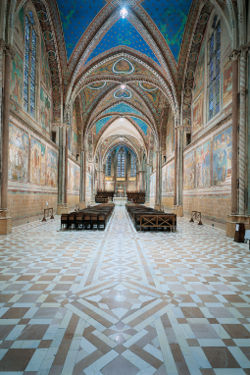Editing Internet Texts/Gothic Architecture in France, England, and Italy/Gothic Architecture in Italy
Gothic in Italy was not consistent and complete. Even though cathedrals have Gothic elements blended in, they are still mostly Romanesque or Renaissance in character.
Basilica of San Francesco of Assisi[edit | edit source]
Siena Cathedral[edit | edit source]
The cathedral was built in Tuscany Romanesque style with Gothic elements. [1] The plan is of a Latin cross form, with a dome and a bell tower. The nave is of 7 bays and is flanked on each side by a singular aisle. The transept slightly projects from the building. The ambulatory is rectangular.
The cathedral was built from marble, which is characteristic of Italian Gothic architecture. Siena Cathedral has one of the most recognisable façades in the world. Works at this façade were started by Giovanni Pisano (who also made sculptures in the lower level) and from about 1296 were continued by Camino de Crescentino. This change of masters is visible in the façade. The higher level has more Gothic ornamentation than the lower. There are three portals, each surmounted by a lunette and a gable. Rose window without any tracery over the middle portal.
The cathedral has three portals, each surmounted by Two levels: arcade and clerestory.
Cathedral of Santa Maria del Fiore, Florence[edit | edit source]
Note: Florence Cathedral's are much smaller compared to French and English Gothic architecture
Milan Cathedral[edit | edit source]
References[edit | edit source]
- ↑ Koch, Wilfried. Style w architekturze. Warszawa: Świat książki. p. 169.











